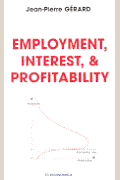Studies in this week’s Hutchins Roundup find that Earned Income Tax Credit expansions have boosted employment, credit card interest rates have risen as a result of regulatory changes following the financial crisis, and more.
Want to receive the Hutchins Roundup as an email? Sign up here to get it in your inbox every Thursday.
The Earned Income Tax Credit increases employment
The federal Earned Income Tax Credit (EITC), which provides a tax subsidy to low-income workers, has been expanded five times since it was introduced in 1975. Diane Whitmore Schanzenbach of Northwestern and Michael R. Strain of the American Enterprise Institute study the collective effect of all five expansions and find that a $1,000 increase in the maximum federal EITC credit is associated with a 3.2 to 3.7 percentage point increase in employment for unmarried mothers with low levels of education. The authors also examine each expansion separately and find that four of the five expansions increased employment for low-education women generally. Moreover, the 1993 expansion, the largest federal expansion and one that coincided with a number of state expansions, is associated with an 11 percentage point increase in employment for unmarried mothers with two children, explaining 59% of the employment increase for this group. The authors conclude that EITC has been an effective anti-poverty program.
Tighter regulation of credit card issuers leads to higher interest rates on consumer credit
Unsecured household debt has been associated with a high risk premium in secondary markets, which is then passed through to high interest rates on consumer credit card debt. Starting in 2010, the consumer credit risk premium climbed dramatically, despite actual credit charge-off risk falling as the economy recovered from the recession. Using Bloomberg data on credit card asset-backed securities, Matthias Fleckenstein of the University of Delaware and Francis A. Longstaff of UCLA find evidence that the rise in the risk premium is due to changes in regulatory requirements since the financial crisis, which increased balance sheet costs to issuers of credit card debt. Consumer credit risk premiums are strongly associated with the required risk-retention ratio, intermediary’s balance sheet constraints, and the cost of balance sheet usage. “Recent capital regulation may have added hundreds of basis points to the overall cost of obtaining unsecured consumer credit in the credit card market”, the authors say— a reminder that “regulation aimed at taming risk-taking on ‘Wall Street’ could have real effects on the availability and terms of credit to ‘Main Street’.”
Total factor productivity growth is higher in the US and less volatile in Europe than typically estimated
Official measures of total factor productivity (TFP) growth, the change in the efficiency with which capital and labor are used, have been falling for the past several years. Diego Comin of Dartmouth College and co-authors find that underlying assumptions may have biased these estimates downward over the past two decades. Typically, TFP estimates assume that firms make zero profits, have no adjustment costs for hiring or investing in capital, and rely on fuzzy measures of how firms utilize capital and employees. Relaxing these assumptions, the authors find higher TFP growth in the U.S. than typically measured—aggregate TFP increased by nearly 27% between 1995 and 2018, versus 23% in widely used measures, and slowed down more gradually than assumed during the Great Recession. In Europe, TFP appears to be less volatile and sensitive to the business cycle than standard methodology suggests; using a direct survey to measure factor utilization largely drives this result.
Chart of the week: GDPs changed drastically in first three quarters of 2020
Chart courtesy of the Wall Street Journal
Quote of the week:
“There is a dilemma that the demand stimulus measures for the overall economy could constrain economic activity if they lead to an increase in the number of confirmed cases of COVID-19. Given that the spread of COVID-19 continues, demand stimulus measures for targeted areas are effective, since prevention of infection and improvement in economic activity can be achieved simultaneously. In this situation, it is important to prevent firms and sole proprietors affected by COVID-19 from facing difficulties in financing and to provide an environment where they can quickly restart their businesses as COVID-19 subsides. Taking into account these points, governments and central banks around the world have focused on protecting businesses and employment in response to the current crisis,” says Haruhiko Kuroda, Governor of the Bank of Japan.
“[Regarding] … stability in financial markets. The economy will fall into a vicious cycle should the following happen: if uncertainties increase over future developments in the economy, financial markets are more likely to become unstable, and turmoil in the markets may negatively affect the real economy through deterioration in firms’ and households’ sentiment. With a view to preventing this vicious cycle, measures to maintain stability in financial markets are important at the time of a crisis. Thus, in the current crisis, the government and central bank of each country have swiftly made policy responses on a large scale, also based on the lessons learned at the time of the Global Financial Crisis.”











Commentary
Hutchins Roundup: EITC, consumer credit, and more
November 5, 2020